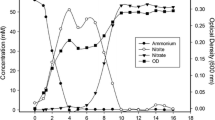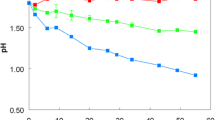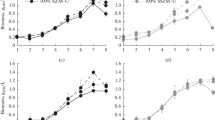Summary
Azospirillum brasilense andArthrobacter giacomelloi were grown in single and mixed succinate-limited continuous cultures at a partial oxygen pressure of 0.01atm. Growth, viability and survival during nutrient starvation were examined at various dilution rates. At D=0.05 h−1, Ks values for succinate consumed were calculated.Arthrobacter giacomelloi viability was inversely related to dilution rate whereasAzo. brasilense was directly related. Slightly lower values of viability were obtained in mixed culture, but the ratio between the microorganisms was constant. The survival ofArth. giacomelloi in single culture decreased with increasing growth rate while survival ofAzo. brasilense was directly related to dilution rate. Acetylene reduction activity was generally very low in both single and mixed cultures. Respiration rate was also determined and the mixed culture showed an oxygen uptake rate higher than that of single cultures.
Similar content being viewed by others
References
Cacciari I, Giovannozzi-Sermanni G, Grappelli A and Lippi D 1971 Nitrogen fixation byArthrobacter sp. I Taxonomic study and evidence of nitrogenase activity of two new strains. Ann. Microbiol. Enzimol. 21, 97–105.
Cacciari I, Lippi D and Bordeleau L M 1979 Effect of oxygen on batch and continuous cultures of a nitrogen-fixingArthrobacter sp. Can. J. Microbiol. 25, 746–751.
Cacciari I, Lippi D, Ippoliti S and Pietrosanti W 1983 Respiratory activity, molar growth yields and ATP content in anArthrobacter sp. ammonium-limited chemostat culture. Can. J. Microbiol. 29, 1136–1140.
Cacciari I, Lippi D, Ippoliti S, Del Gallo M, Pietrosanti T and Pietrosanti W 1984 Growth and nitrogen fixation of mixed cultures ofAzospirillum brasilense andArthrobacter giacomelloi.In Advances in Nitrogen Fixation Research. Eds C Veeger and W E Newton, M Nijhoff and W Junk Publishers, Pudoc, Wageningen, p. 329.
Dalton H and Postgate J R 1969 Effect of oxygen on growth ofAzotobacter chroococcum in batch and continuous cultures. J. Gen. Microbiol. 54, 463–473.
Ferrari A M and Zannini E 1958 Ricerche sulle specie del genereFlavobacterium. Ann. Microbiol. Enzimol. 8, 138–150.
Gray T R G 1976 Survival of vegetative microbes in soil. Symp. Soc. Gen. Microbiol. 26, 327–364.
Harrison D E F 1976 The regulation of respiration rate in growing bacteria. Adv. Microb. Physiol. 14, 243–309.
Jannasch H W and Mateles R I 1974 Experimental bacterial ecology studied in continuous culture. Adv. Microb. Physiol. 11, 165–212.
Kapulnik Y, Sarig S, Nur I and OkonY 1983 Effect ofAzospirillum inoculation on yield of field-grown wheat. Can. J. Microbiol. 29, 895–899.
Kemp C W, Robrish S A, Curtis M A, Sharer S A and Bowen W H 1983 Application of a competition model to the growthStreptococcus mutans andStreptococcus sanguis in binary continuous culture. Appl. Environ. Microbiol. 45, 1277–1282.
Kloss M, Iwannek K H and Fendrik I 1983 Physiological properties ofAzospirillum brasilense Sp 7 in a malate-limited chemostat. J. Gen. Appl. Microbiol. 29, 447–457.
Lowry O H, Rosenbrough N J, Farr A L and Randall R J 1951 Protein measurements with the Folin phenol reagent. J. Biol. Chem. 193, 265–275.
Matin A and Veldkamp H 1978 Physiological basis of the selective advantage of aSpirillum sp. in a carbon-limited environment. J. Gen. Microbiol. 105, 187–197.
Mink R W and Hespell R B 1981 Long-term nutrient starvation of continuously cultured (glucose-limited)Selenomonas ruminantium. J. Bacteriol. 148, 541–550.
Mulder E G and Antheunisse J 1963 Morphologie, physiologie et écologie desArthrobacter. Ann. Inst. Pasteur, Paris 105, 46
Okon Y 1982Azospirillum: Physiological properties, mode of association with roots and its application for the benefit of cereal and forage grass crops. Isr. J. Bot. 31, 214–220.
Poindexter J S 1981 Ologotrophy: Fast and famine exitence. Adv. Microb. Ecol. 5, 63–89.
Smith R L, Shank S C, Milam J R and Baltensperger A A 1984 Responses ofsorghum andPennisetum species to the N2-fixing bacteriumAzospirillum brasilense. Appl. Environ. Microbiol. 47, 1331–1336.
Veldkamp H 1976Mixed culture studies with the chemostat.In Sixth International Symposium on Continuous Culture. Eds A C R Dean, D C Ellwood, C G T Evans and J Melling, Ellis Horwood Publisher Ltd., Chichester, United Kingdom, pp 315–326.
Von Bülow J F W and Döbereiner J 1975 Potential for nitrogen fixation in maize phenotypes in Brazil. Proc. Natl. Acad. Sci. USA 72, 2389–2393.
Williamson J R 1963 Succinate.In Methods of Enzymatic Analysis, Vol. 3. Ed. H U Bergmeyer, Acad. Press, New York, pp 1616–1621.
Author information
Authors and Affiliations
Additional information
Research work supported by CNR, Italy. Special grant I.P.R.A. Sub-project 1. Paper N. 317.
Rights and permissions
About this article
Cite this article
Cacciari, I., Del Gallo, M., Ippoliti, S. et al. Growth and survival ofAzospirillum brasilense andArthrobacter giacomelloi in binary continuous culture. Plant Soil 90, 107–116 (1986). https://doi.org/10.1007/BF02277390
Issue Date:
DOI: https://doi.org/10.1007/BF02277390




